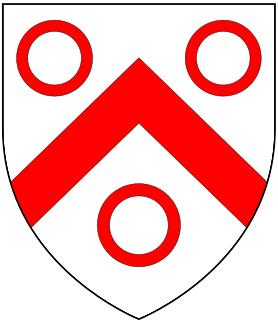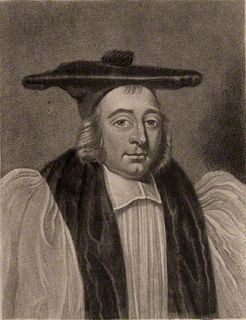Arms
 |
|
George Owen (died 1665) was a Welsh officer of arms, York herald from 1633.
The son of George Owen of Henllys, by his second wife, he was conceived out of wedlock, and born at Henllys in Pembrokeshire. He was appointed Rouge Croix Pursuivant in place of John Bradshaw on 28 February 1626, and was promoted to the post of York herald by signet in December 1633, and by patent 3 January following. [1]
Owen attended the Earl of Arundel in the First Bishops' War of 1639, and, according to Anthony Wood, was despatched on a mission in the king's service to Wales in following year. He was with the retinue of Charles I at Oxford in 1643, where, on 12 April, he was created D.C.L., and he subsequently accompanied the king when the royal forces moved to invest Gloucester on 10 August. [1]
At some point after early 1645, Owen was asked to act as deputy to the Clarenceux King of Arms, William Le Neve, who had been sent abroad. Owen then went over to the parliamentary side, being confirmed as York herald. Officiating at events of the new regime, he was nominated successively as Clarenceux and Norroy King of Arms; but was on bad terms with Sir Edward Bysshe, the Garter King of Arms. [2]
In 1660 Owen was reappointed York herald, and held the office until he resigned it in 1663, when he was succeeded by his son-in-law, John Wingfield. With Elias Ashmole, he directed the funeral in London of Bryan Walton, on 5 December 1661. He died in Pembrokeshire 13 May 1665. [1]
Owen has been widely confused with his father, and with George ap Owen ap Harry, called George Owen Harry. Owen's own heraldic work includes his grant of a coat-of-arms in 1654 to Colonel Philip Jones, now preserved at Fonmon Castle, Glamorganshire, and the illuminated "Golden Grove Pedigree Parchment Roll", dated 1641, of the pedigree of the Vaughans, Earls of Carbery. [1]
Owen married Rebecca, daughter of Sir Thomas Dayrell of Lillingstone Dayrell, Buckinghamshire, by whom he had two sons, who both died without issue, and a daughter, who was married to his successor, John Wingfield. [1]
 |
|
![]() This article incorporates text from a publication now in the public domain : Lee, Sidney, ed. (1895). "Owen, George (d.1665)". Dictionary of National Biography . 42. London: Smith, Elder & Co.
This article incorporates text from a publication now in the public domain : Lee, Sidney, ed. (1895). "Owen, George (d.1665)". Dictionary of National Biography . 42. London: Smith, Elder & Co.

The Right Honourable the Lord Lyon King of Arms, the head of Lyon Court, is the most junior of the Great Officers of State in Scotland and is the Scottish official with responsibility for regulating heraldry in that country, issuing new grants of arms, and serving as the judge of the Court of the Lord Lyon, the oldest heraldic court in the world that is still in daily operation.

George Owen of Henllys was a Welsh antiquarian, author, and naturalist.

George Edward Cokayne,, was an English genealogist and long-serving herald at the College of Arms in London, who eventually rose to the rank of Clarenceux King of Arms. He wrote the authoritative and standard reference works The Complete Peerage and The Complete Baronetage.
Sir Charles Townley was a long-serving officer of arms at the College of Arms in London.

Heraldic visitations were tours of inspection undertaken by Kings of Arms throughout England, Wales and Ireland. Their purpose was to register and regulate the coats of arms of nobility, gentry and boroughs, and to record pedigrees. They took place from 1530 to 1688, and their records provide important source material for historians and genealogists.

John Harington, 1st Baron Harington of Exton in Rutland, was an English courtier and politician.

There have been two baronetcies created for persons with the surname Goring, both in the Baronetage of England. The second creation came into the family through a special remainder in the patent creating the baronetcy. Only the latter creation is extant as of 2008.

Nicholas Monck was a Bishop of Hereford and Provost of Eton College, both royal appointments made by King Charles II following the 1660 Restoration of the Monarchy which was largely effected by his elder brother George Monck, 1st Duke of Albemarle (1608–1670), KG. Nicholas Monck was "a great assistant in the Restoration to his brother".

Gilbert Ironside the elder (1588–1671) was Bishop of Bristol.
William Paul was an English royal chaplain and bishop of Oxford.

Ralph Brooke (1553–1625) was an English Officer of Arms in the reigns of Elizabeth I and James I. He is known for his critiques of the work of other members of the College of Arms, most particularly in A Discoverie of Certaine Errours Published in Print in the Much Commended 'Britannia' 1594, which touched off a feud with its author, the revered antiquarian and herald William Camden.
William Flower (1497/98–1588) was an English Officer of Arms in the reigns of Henry VIII, Edward VI, Mary I and Elizabeth I. He rose to the rank of Norroy King of Arms, serving in that capacity from 1562 until his death in 1588.

Robert Glover was an English Officer of Arms, genealogist and antiquarian in the reign of Elizabeth I. In the College of Arms, he rose to the rank of Somerset Herald of Arms, serving in that capacity from 1571 until his death in 1588. As marshal and deputy to his father-in-law, William Flower, Norroy King of Arms, he participated in heraldic visitations throughout northern England.

Robert Cooke was an English Officer of Arms during the reign of Elizabeth I, who rose swiftly through the ranks of the College of Arms to Clarenceux King of Arms, serving in that office from 1567 until his death in 1592–3.
Sir John Borough, sometimes Burroughs, was the Garter Principal King of Arms 1633-43.
Sir John Maclean KB, FSA was a British civil servant, genealogist and author.
Henry St George, the younger, was an English officer of arms. He was a younger son of the herald Henry St George (1581–1644).
Sir Henry St George (1581–1644) was an English Officer of arms. He was the third son of the herald Sir Richard St George and his wife Elizabeth St John..

Sir William Le Neve (1600?–1661) was an English herald and genealogist.
William Ryley was an officer of arms at the College of Arms in London.